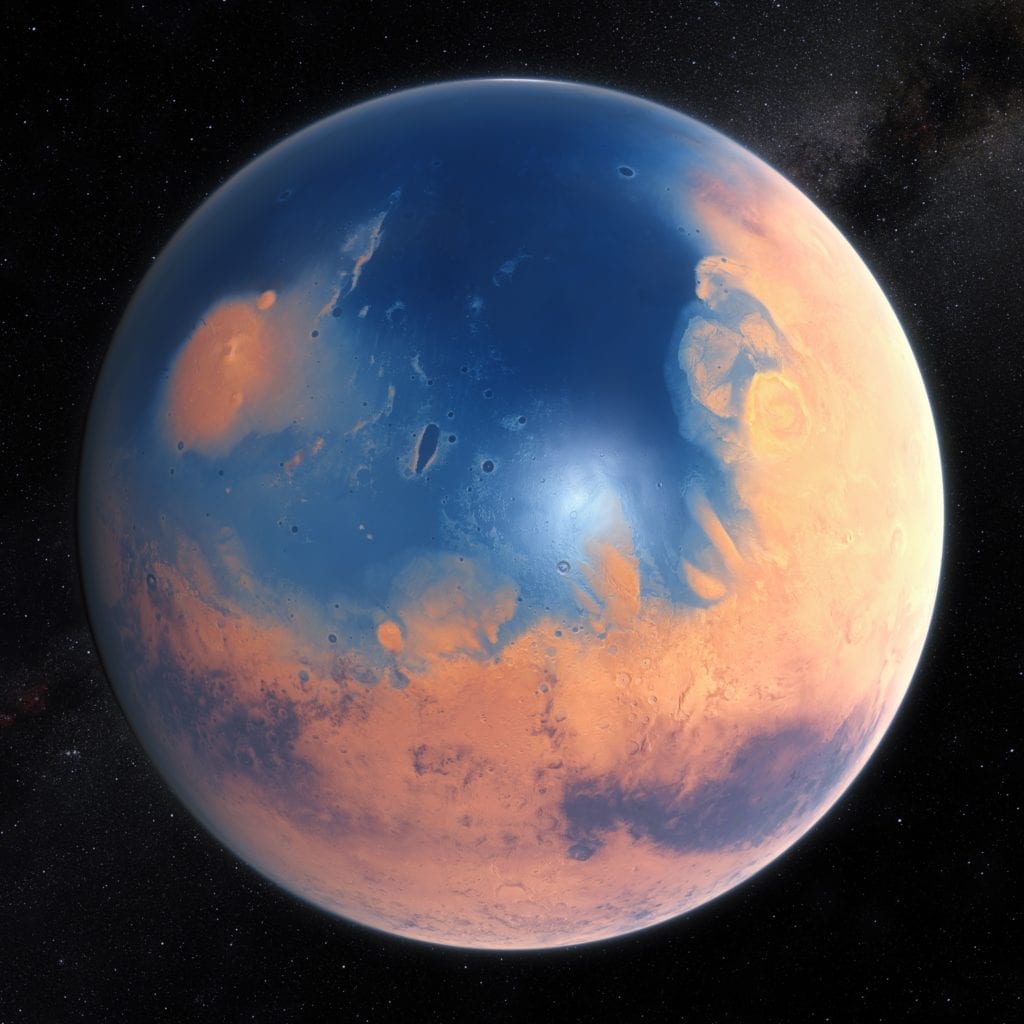General
If you look at Mars Surface in the sky, its orange to blood-red coloration is already noticeable with the naked eye, which is why it was named Mars (or Ares), the god of war. The reason for the red coloration is the chemical composition of its surface: it has a very high proportion of iron oxides, commonly known as rust. The fine iron oxide dust covers the ground and is additionally distributed in the thin atmosphere of the planet due to the wind.

Above: This 360-degree panoramic image was taken over a period of three Mars days from the lander of the Mars Pathfinder mission. The lander photographed a different direction at about the same time. The long period of time was necessary to ensure the same lighting conditions for each region photographed, for example to ensure that the shadows cast by the stones were constant. This is an optimized version, which almost compensates for perspective distortions. The image shows the typical surface of Mars: Characterized by intense red tones, it is covered by smaller and larger boulders.
The metal rod in the left part of the picture belongs to an antenna of the Mars Pathfinder. A little further to the right you can see the “Twin Peaks” – twin hills on the horizon, one or two miles away. Almost directly below, you can see the ramp that the small Mars rover “Sojourner” used to drive from the landing unit to the surface of Mars. The tracks of the vehicle are also visible and lead to a striking rock, which was given the name “Yogi”. In the picture, Sojourner is currently analyzing the rock with his alpha-proton X-ray spectrometer. Further right on the photo you can see two more landing flaps of the Pathfinder, each with remnants of the airbags that cushioned the landing.

As a result of the more precise recording and observation of the surface of Mars with the help of increasingly powerful instruments, there has recently been increasing evidence that there was once a large ocean on Mars. The illustration on the right shows the possible extent of an ocean that could have covered large areas of the low-lying plains on Mars three to four billion years ago. It is based on data from the MARSIS radar on board ESA’s Mars Express spacecraft. With its radar waves, the instrument can penetrate up to 80 meters into the Martian soil and provide scientists with information about the soil properties and its composition. During a study, the data was evaluated and it was concluded that in certain regions icy sedimentary deposits can be found that strongly resemble a former sea floor. These regions are located within rock formations that have been identified as early coastlines.
Tharsis Montes
The Tharsis region is one of the most extensive large-scale landscapes on the Red Planet. You can even see it from orbit, as long as no sand and dust storms obstruct the view. As already mentioned, it is a volcanic plateau with a total area of about four million square kilometers. It is located close to the Martian equator, with the largest part extending into the southern hemisphere. The picture above was taken in April 1999 by the NASA probe “Mars Global Surveyor” and shows the central area of Tharsis Regio with the four mighty shield volcanoes and the Valles Marineris trench system. On the upper left is Olympus Mons, a little to the right of it the diagonally from bottom left to top right running Tharsis Montes, consisting of the shield volcanoes Arsia Mons, Pavonis Mons and Ascraeus Mons. The summits of the shield volcanoes are surrounded by bluish-white water ice clouds. In the eastern part of Tharsis is the largest canyon system in the solar system, Valles Marineris.
Arabia Terra
Arabia Terra is a vast plateau directly opposite the Tharsis region on the other side of the planet. In the adjacent photo of the Mars Global Surveyor, Arabia Terra is visible as a large bright area on the Mars globe. The maximum extension of the plateau is about 5,000 kilometers, with the southern and eastern areas being about four kilometers higher than the northern and western areas. Arabia Terra was formed at least 3.9 billion years ago, making it one of the oldest large-scale landscapes on Mars. Due to its advanced age, the plateau is home to many craters of all sizes, which, together with other surface structures, were exposed to strong erosion processes over long periods of time. An exception to this is the crustal rocks, which are covered by the ejected material of the craters and are thus protected from erosion. Arabia Terra attracted a lot of attention in 2004 when the Mars Express probe registered an increased water vapor content in the atmosphere above the area. The dark region that projects somewhat into Arabia Terra to the southeast is Syrtis Major.
Elysium Planitia
Elysium Planitia is the second largest volcanic landscape on Mars after the Tharsis region to the east and is one of the northern lowlands of the planet. In the early days of Mars, the region was repeatedly covered by extensive lava flows. In the process, numerous impact craters were also flooded by lava, so that often only the crater edges are still visible because they rise slightly above the surrounding area.
Utopia Planitia
Worth mentioning is also Utopia Planitia, an extensive lowland plain in the northern hemisphere of the Red Planet. Science fiction fans may know the name from the Star Trek universe – there you will find fleet shipyards and Starfleet maintenance facilities, but only by the way (sometimes the sci-fi freak in me gets the upper hand). The photo on the left was taken on May 18, 1979 by the camera of Viking Landers 2, which had landed safely on the surface of Mars shortly before. You can see a thin layer of water ice that has settled over the ground and the surrounding rocks. The time of ice formation coincides with the seasonal formation of frost on Mars. The frost layer remained on the cold ground for about 100 days before temperatures began to rise again. Contrary to first impressions, it is extremely thin, not even one millimeter thick. According to the scientists, dust particles attach themselves to water ice crystals, but their total mass is not sufficient to sink to the ground. Only when carbon dioxide from the Martian atmosphere attaches itself to the dust-water ice particles do they become heavy enough to fall to the ground and form a layer of ice.
Cydonia Mensa
When reporting on the nature of the surface of Mars, the mention of Cydonia Mensa is actually obligatory. Located between Arabia Terra and Acidalia Planitia, this highland region is heating up the creation of myths and legends about the Red Planet like hardly any other region – and has been doing so for over 30 years. The main reason for this are two inconspicuous photographs taken by the two Viking orbiters in 1976. At first hardly noticed, on closer inspection they showed a structure that bears an astonishing resemblance to a human face (see picture on the left, just above the center of the image). In other pictures of the series, several pyramid-like formations were found, which since their discovery have been called “Inca city”. These photographs became the birth helpers of the myth, according to which Mars was the home of an intelligent advanced civilization a very long time ago, but which was then completely destroyed by a catastrophe, perhaps an asteroid impact. In one version of this legend, some of the beings that were already powerful in high technology, including space travel, many millions of years ago survived and were able to take refuge on Earth. There, with the help of their technical abilities, they quickly set up a base, which in turn built a bridge to another legend: Atlantis.





